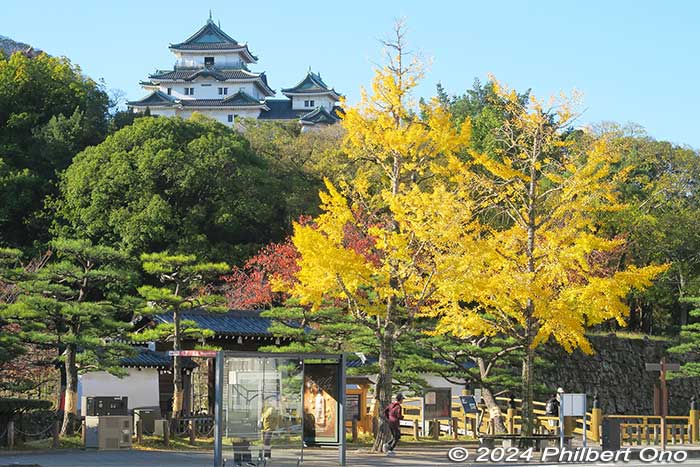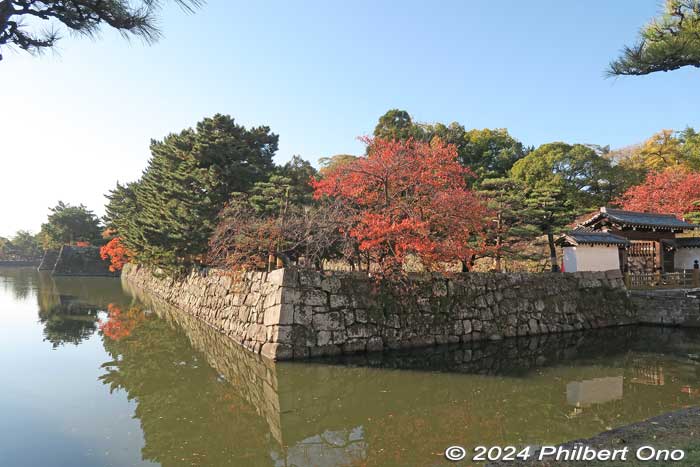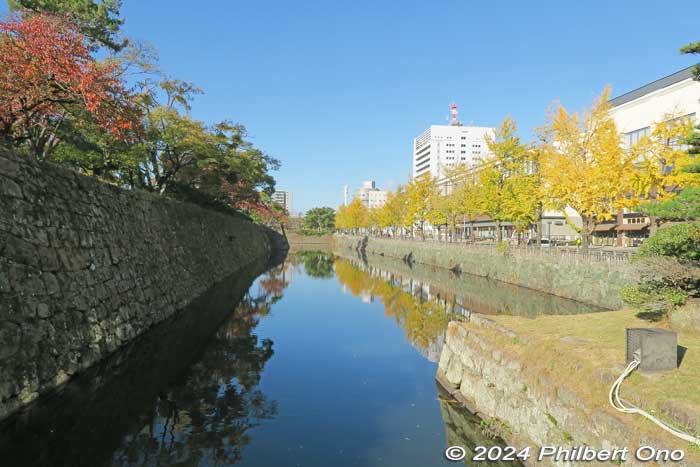


Wakayama Castle (和歌山城) is the symbol of the city with impressive castle buildings including the main castle tower reconstructed in October 1958. Although it’s more famous for cherry blossoms, Wakayama Castle also has a very pretty enclave of autumn foliage in one corner of the castle grounds.
The prime time for autumn foliage in Wakayama is usually from late November to early December. These photos were taken in early December 2024 when the autumn foliage was late due to unusually warm temperatures.
Nishinomaru Teien Garden (Momiji-dani Teien)
From the Otemon Gate main entrance (next to the Wakayamajo-mae bus stop), it’s a short walk to the nice Japanese garden named Nishinomaru Teien (西之丸庭園), nicknamed “Momiji-dani Teien” (Maple Valley Garden 紅葉渓庭園) next to the Nishinomaru keep.
Open 9:00 am–5:00 pm (enter by 4:45 pm). Closed Dec. 29 to 31. Free admission to the garden.

Designated as a National Scenic Place, Maple Valley Garden is in a small depression centering on a pond surrounded by maples and pine trees and complemented by a small, floating pavilion named Engyokaku (鳶魚閣).
The garden has a varied, rocky terrain with both hillside and pond-side walking paths and small bridges. They provide many splendid scenic points of the thick autumn foliage and pond. The pond is fed by a natural spring.

Classified as a castle garden or daimyo garden, Nishinomaru Teien Garden was built in the 17th century by Tokugawa Yorinobu (1602–1671) to complement his Nishinomaru Goten retirement palace. The garden was a place for him to relax and enjoy tea.
Yorinobu was the first daimyo and Wakayama Castle lord of Kishu Province (now Wakayama Prefecture) who started the Kii branch of the Tokugawa Clan. He was the tenth son of Shogun Tokugawa Ieyasu who unified Japan in the early 1600s and started the peaceful Edo Period.

The custom of building a castle garden was started by powerful samurai warlords Oda Nobunaga and Toyotomi Hideyoshi (Osaka Castle) in the 16th century. The garden would typically feature a pond and rocks to symbolize the ocean, valley, and mountains.

Momiji-dani Teien garden is believed to have been originally designed either by famed gardener Kobori Enshu (小堀遠州) as ordered by Yorinobu or by Asano Clan samurai retainer Ueda Soko (上田宗箇) aka Ueda Shigeyasu.
In 1973 at the Imperial Palace in Tokyo, remains of a garden pond between the Honmaru and Ninomaru keeps of the old Edo Castle was found to be very similar to the pond at Nishinomaru Teien Garden. Therefore, experts are inclined to believe Momiji-dani Teien garden was designed by Kobori Enshu.

Wakayama Castle’s Ohashiroka Bridge (御橋廊下) over the moat is a covered corridor connecting the Ninomaru keep and Nishinomaru keep where the Momijidani Garden is. Only the castle lord’s immediate attendants could cross the bridge, and so it was completely covered.


Today, anybody can cross the bridge (free admission), but be aware of the wooden planks on the floor whose edges are painful to step on barefoot. (You have to take off your shoes.) It’s best to wear the provided slippers. The planks supposed to prevent you from slipping down the bridge floor. Ohashiroka Bridge is made of wood with a slight slope. It is a rare castle structure rebuilt in April 2006.







Wakayama Castle was originally built in 1585 by Toyotomi Hidenaga upon the order of elder brother and powerful warlord Toyotomi Hideyoshi. The construction was directed by renown castle architect Lord Todo Takatora, native of Omi Province (Shiga Prefecture). After the Battle of Sekigahara in 1600, Wakayama Castle was bestowed to the Asano Clan who expanded the castle including the construction of the main tower.
The Asano Clan moved to Hiroshima in 1619 and were replaced by Tokugawa Yorinobu as one of the three branches of the Tokugawa eligible to provide the shogun’s successor in case the main family line does not produce an heir.

The main castle tower was destroyed by World War II bombing in 1945 and rebuilt in ferroconcrete in October 1958. It serves as a local museum and has great views of the city from the top floor. Note that while the garden has free admission, the castle tower charges a small admission. Open 9:00 am–5:30 pm (enter by 5 pm).
Getting to Wakayama Castle
・From JR Wakayama Station, take the No. 0 or No. 25 bus and get off at the Wakayamajo-mae bus stop near the East Moat and Otemon Gate, the main entrance. Short bus ride.
・From Nankai Wakayama-shi Station, it’s about a 15-min. walk or you can take a bus (Bus stop 1).
Wakayama Castle is more famous for cherry blossoms in spring. Lots of them all over (photos here).
Also see autumn at Koya-san, Kumano Sanzan Shrine Trio (Hongu Taisha, Hayatama Taisha, Nachi Taisha and Falls), and Shingu Castle.
Sources: https://www.nwn.jp/feature/171202_nisinomaru/